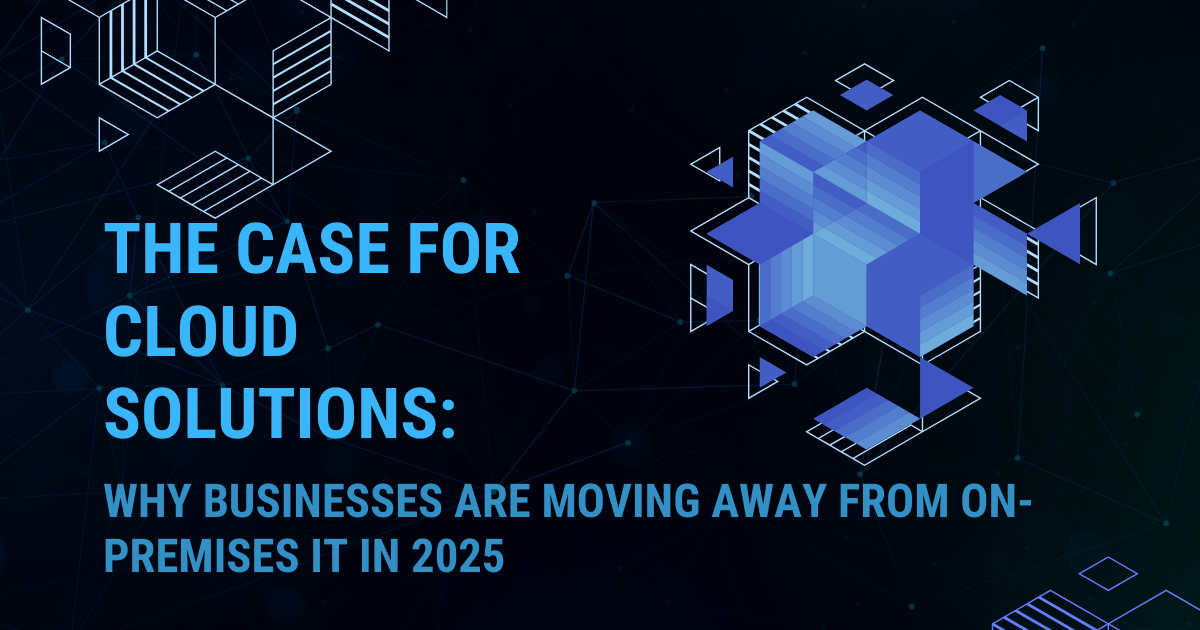The Case for Cloud Solutions: Why Businesses Are Moving Away from On-Premises IT in 2025
The modern business environment is changing rapidly. From remote work to cyber threats and evolving customer expectations, companies face mounting pressure to maintain agility while keeping IT costs under control. For many, the answer is no longer more on-premises servers—it’s Cloud Solutions.
Cloud computing allows businesses to access software, storage, and processing power over the internet instead of relying solely on in-house infrastructure. The shift isn’t just a trend; it’s a strategic move that can transform operations, reduce costs, and improve resilience.
Why On-Premises IT is Challenging Today
On-premises servers and local IT infrastructure have traditionally been the backbone of business operations. However, they come with limitations:
- High upfront costs: Buying and maintaining servers, software licenses, and networking hardware can strain budgets.
- Maintenance burden: IT teams spend significant time on updates, patches, and troubleshooting.
- Scalability issues: Adding capacity often requires purchasing new hardware, which can be slow and expensive.
- Limited remote access: Employees working offsite may struggle to access critical systems securely.
These challenges are driving companies to seek solutions that offer flexibility, scalability, and lower operational complexity.
What Are Cloud Solutions?
Cloud Solutions provide access to computing resources, software, and storage via the internet. There are three primary models:
- Public Cloud: Hosted by third-party providers and shared across multiple organizations. Offers cost efficiency and rapid scalability.
- Private Cloud: Dedicated infrastructure for a single organization, often with higher security controls.
- Hybrid Cloud: Combines on-premises systems with cloud infrastructure, offering a balance between control and flexibility.
Cloud adoption is not just about technology—it’s about empowering businesses to operate more efficiently and securely in a fast-moving environment.
The Business Advantages of Cloud Solutions
Implementing cloud solutions can deliver transformative benefits:
- Cost Efficiency: Pay-as-you-go models eliminate large upfront investments and reduce ongoing maintenance costs.
- Scalability: Instantly adjust storage and computing power to match business needs, avoiding overprovisioning or downtime.
- Remote Access: Employees can securely access applications and data from anywhere, supporting hybrid and remote work models.
- Automatic Updates: Software updates, security patches, and maintenance are handled by the cloud provider, freeing IT teams.
- Enhanced Security: Leading providers invest in advanced security measures and compliance certifications that many businesses cannot replicate in-house.
The combination of cost, flexibility, and security makes cloud adoption a strategic priority for modern businesses.
Real-World Impact
Consider a mid-sized marketing firm that relied heavily on on-premises servers. During a sudden IT outage, they lost access to client files and campaign data for several hours. By moving to a hybrid cloud solution, they not only eliminated this single point of failure but also gained the ability for their team to collaborate remotely without disruptions. Productivity improved, operational costs dropped, and the business became far more resilient.
Statistics support this trend: over 90% of businesses report at least some cloud adoption in 2025, with a significant portion citing cost savings, operational flexibility, and business continuity as top benefits.
Steps to Evaluate Cloud Solutions for Your Business
Transitioning to the cloud should be strategic and informed. Consider these steps:
- Assess Needs: Identify which applications and data will benefit most from cloud deployment.
- Determine the Model: Choose public, private, or hybrid based on security, control, and cost requirements.
- Evaluate Providers: Look for reliability, uptime guarantees, security certifications, and scalability.
- Plan the Migration: Schedule migrations carefully to minimize downtime and operational disruption.
- Train Staff: Ensure employees understand how to access and use cloud tools effectively.
Planning carefully ensures that the move to cloud solutions delivers maximum impact without unexpected complications.
How PC Works Tech Supports Cloud Adoption
At PC Works Tech, we provide Cloud Solutions designed to simplify IT for small and midsize businesses. Key benefits include:
- Affordable, scalable cloud access tailored to your business size.
- 24/7 secure access from anywhere, enabling remote and hybrid work.
- No hardware headaches: We manage infrastructure, updates, and maintenance.
- Business continuity: Your data and applications remain accessible even during unexpected disruptions.
With PC Works Tech, businesses gain the flexibility and security they need to operate confidently in today’s digital world.
Conclusion
Cloud solutions aren’t just a technology upgrade—they’re a strategic shift that allows businesses to operate efficiently, securely, and with flexibility. By understanding the benefits and planning a thoughtful migration, companies can reduce costs, improve resilience, and stay ahead in an increasingly competitive environment.
Learn more about PC Works Tech’s Cloud Solutions:




No responses yet